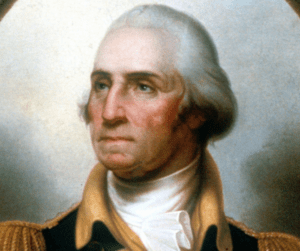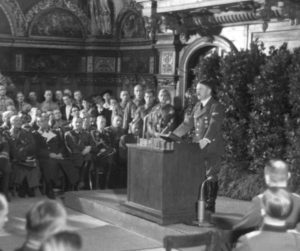U.S. Wars
Note that this history involves U.S. wars. It does not include the War Between the States because no foreign powers were involved.
The American Revolution
With the signing of the Treaty of Paris on September 3, 1783, the American Revolution came to a successful close after eight long years.
Barbary Pirates
The Barbary States were a collection of North African states, many of which practiced state-supported piracy in order to exact tribute.
In 1804, President Jefferson decided to introduce the Barbary pirates to the full force of the United States Navy and Marines.
The conclusion of the war in 1805 set off a wave of pride among Americans.
No one declared war, but the United States got what they were after.
“From The Halls of Montezuma to the Shores of Tripoli …”
The War of 1812
The British needed men for their ships and decided that United States merchant vessels were fair game. They began stopping American merchant ships at sea and forcing the crews into service for the Royal Navy. This is known as impressment. They forced as many as 10,000 Americans into British service.
When negotiations failed, on June 18, 1812, President Madison signed a declaration of war against Great Britain. He was the first President to sign a declaration of war.
On December 24, 1814, commissioners signed the Treaty of Ghent. For the second time, the U.S. won a war against the strongest military in the world.
As a footnote, the Battle of New Orleans was fought in January 1815 after the Treaty of Ghent was signed because neither side was aware of the Treaty.
The Americans handily won a large-scale and very bloody battle against experienced British regulars which had the support of the British Navy.
Total American casualties, were about 40 (casualties vary wildly). The total British battle casualties were over 2,000; an overwhelming loss.
Mexican-American War
Mexico did not like the idea of Texas becoming an American State.
On April 25, 1846, Mexican cavalry attacked U.S. soldiers and killed about a dozen.
Then on May 13, 1846, Congress declared war on Mexico.
On September 14, 1847, United States forces entered Mexico City and raised the American flag over the Hall of Montezuma.
“From The Halls of Montezuma to the Shores of Tripoli …”
On Feb. 2, 1848, the Treaty of Guadalupe Hidalgo was signed, which established the Rio Grande as the U.S.-Mexican border.
Spanish-American War
On February 15, 1898, a huge explosion sank the battleship USS Maine in Havana Harbor.
On April 25th, 1898, The United States declared war on Spain.
The fight was unequal to the extreme. The U.S. defeated the Spanish decisively on both land and sea in very short order.
The United States and Spain agreed to an armistice in August 1898, which stopped the fighting.
On December 12, 1898, the Treaty of Paris was signed between the United States and Spain, and Spain ceded Puerto Rico, Guam, and the Philippines to the United States.
World War I (the Great War)
On June 28,1914, Archduke Francis Ferdinand, heir to the Austro-Hungarian throne, was assassinated.
Then on July 28, 1914, Austria-Hungary declared war on Serbia, beginning World War I.
Almost three years later, on April 6, 1917, The United States declared war on Germany.
On November 11, 1918 the Armistice was signed, and Germany and its allies were defeated.
World War II
On September 1, 1939, German forces under the control of Adolf Hitler invaded Poland, beginning World War II
The day after the Japanese surprise attack on Pearl Harbor on December 7, 1941, the U.S. declared war on Japan.
Shortly after, Germany declared war on the U.S.
Suddenly, the U.S. was involved in a two-front, two-ocean war.
On May 7, 1945. Germany unconditionally surrendered. The following day is recognized as V-E Day.
On August 14, 1945, Japan surrendered and there was a peace treaty. The following day is recognized as V-J Day.
On September 2, 1945, General MacArthur accepted Japan’s unconditional surrender on the battleship USS Missouri.
Not Quite Wars
In the previous section, “Wars,” you may have noticed the United States won every time.
Things change.
Oh, yes, the last time the United States has been officially at war was in 1945, World War II. After that, we have been in “conflicts” which are sometimes referred to as “police actions.”
The United States Department of Defense
In 1949, the departments of all military branches were placed under the new United States Department of Defense. There was no more War Department.
On a personal note, I prefer Department of War because it says, “We mean business.”
The Korean Conflict
After three years of fighting, the war ended in a stalemate with the border between North and South Korea near where it had been at the war’s beginning.
Note that this was a “conflict” because there was no declaration of war. But, with well over 36,000 American deaths, it had all the earmarks of a war.
The “conflict” lasted from June 25, 1950 to July 27, 1953.
Also note that the United States didn’t win.
Vietnam Conflict
Again, this was a “conflict” because there was no declaration of war.
There had been fighting in Vietnam long before United States became heavily involved.
In 1961, President John F. Kennedy sent a team of advisors.
By 1962, the U.S. had 9,000 troops in Vietnam, compared with fewer than 800 during the 1950s.
Over the years, the number of U.S. ground forces well exceeded 500,000.
In January 1973, an agreement was reached; U.S. forces were withdrawn from Vietnam.
In April 1975, South Vietnam surrendered to the North, and Vietnam was reunited as a communist country.
The Vietnam War cost the United States 58,000 lives and 350,000 casualties. As with Korea, this “conflict” seemed very much a war.
Also note that the United States didn’t win.
Mid-East Conflicts
The beginning of our seemingly endless war, I mean conflict, in the Mid-East began with the Iraqi invasion of Kuwait on August 2, 1990. All we did was to push Iraq back to its own territory.
Then there was the Iraq War which was another conflict, and resulted in the execution of Saddam Hussein. And moved the U.S. into another mess.
On September 11, 2001, al-Qaeda terrorists attacked our country. And we were fighting in Afghanistan.
August 30, 2022 marked the end of the U.S. fighting in Afghanistan. The “conflict” had been going on since 2001, 21 years.
The entire period of fighting had been over 30 years.
The war in Afghanistan was the most embarrassing in the history of U.S. wars. The United States left everything, including billions of dollars of military equipment to the Taliban, and then we ran away.
Summary: A fiasco, total surrender.
Appeasement Doesn’t Work
The Most Recent Appeasement
Currently, all sanctions against Iran have been ignored by our government. We are allowing Iran to amass billions of dollars and we could well allow Iran to produce nuclear weapons.
The current thinking seems to be that if we are really nice to Iran, they will be really nice guys. Just forget that the United States is referred to as “the Great Satan.”
As of October 2023, Iran started serious problems by attacking Israel and United states forces using proxies. That is, terrorists organizations not directly associated with Iran.
Flash Back to World War Two
Neville Chamberlain served as Prime Minister of the United Kingdom from May 1937 to May 1940.
Chamberlain is best known for his foreign policy of appeasement, and specifically for signing the Munich Agreement on September 30, 1938, which ceded the German-speaking Sudetenland region of Czechoslovakia to Nazi Germany.
Chamberlain returned to London waving a copy of the Munich Agreement and proclaiming, “There will be peace in our time.”
After giving Hitler what he wanted, part of a European country without a shot being fired, Hitler invaded Poland on September 1, 1939 and World War Two began.
What To Make Of All Of This
Keep in mind that this is a personal opinion, and I am sure many will disagree.
Sometimes, Actions Require a Declaration of War
In the previous section, “Not Quite Wars,” you may have noticed the United States never won.
In all of those instances, there was never a clear goal nor a desire to defeat the enemy. The goal always seemed to be, “Let’s calm this down” or “Let’s contain communism.”
Regardless of how many Americans died, it seemed that declaring war was a bit too harsh for the United States.
It is much nicer to have a conflict. It doesn’t seem to matter that, since 1950, many multiple thousands of Americans have been killed or extremely seriously wounded.
And it doesn’t seem to matter that these conflicts never resolve anything except to the possible benefit of the enemy.
In a nutshell, if our government intends to place large numbers of Americans in harm’s way, they should have the courage to declare war.
War Can Be Averted
I am not a complete nut, and there are rational reasons not to immediately declare war.
In late 2023, terrorists organizations have attacked Americans in the Mid-East. What does the United States do? It says, “Please stop,” and then lobs a couple of missiles. That’s the wrong thing to do. Don’t give them a short left jab, destroy them. War need not be declared unless the nation supporting the terrorists becomes directly involved with attacking Americans.
Iran has flagrantly ignored sanctions imposed upon them, and the United States has foolishly allowed them to get away with it. We need to stop the oil transports and cut off billions of dollars going to Iran. Declare war only if Iran starts a fight.
There is another exception to war, and President Reagan gave us a perfect example.
The invasion of Grenada by the United States that occurred October 25–28, 1983 was for a well-defined reason. There was a threat to about 1,000 American nationals. President Ronald Reagan ordered U.S. forces to invade and secure their safety. In other words, there was a well-defined goal. The U.S. accomplished its goal and left.
Conclusion
All I am saying is, with the economy and military might of the United States, we can do things correctly. And this includes diplomatic relationships. Have a well-defined goal to achieve and fight to win.










